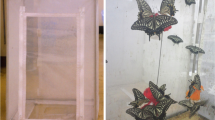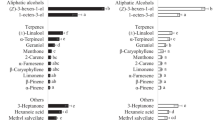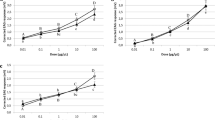Abstract
We used the electroantennogram (EAG) technique to compare the antennal sensitivity of both sexes of the giant swallowtail butterfly, Papilio cresphontes to four doses (1, 10, 100, and 1,000 μg) of the leaf essential oils of Zanthoxylum clava-herculis and Ptelea trifoliata (key host plants) and Sassafras albidum (a marginal or non-host plant). The main hypothesis tested was that P. cresphontes will show greater olfactory sensitivity to volatiles of the key host plants than to volatiles of the marginal host plant, in particular at low doses. At the lower doses, extract of the key host plant, Z. clava-herculis elicited greater EAG responses in both sexes than extracts of the remaining two plants. At higher doses, however, extracts of P. trifoliata and S. albidum elicited greater EAG responses than extract of Z. clava-herculis. These results partly support our hypothesis and may suggest that Z. clava-herculis is a more preferred host plant of P. cresphontes than P. trifoliata. In general, female butterflies showed greater EAG responses than males to the three plant extracts at the higher doses. Preliminary coupled gas chromatography-electroantennogram (GC-EAD) tests revealed four components each from Z. clava-herculis and P. trifoliata (three peaks common to both extracts) and seven from S. albidum (one shared with Z. clava-herculis) which elicited GC-EAD activity in P. cresphontes females, but the peaks were un-indentified because most were detected in trace amounts. In addition, the chemical composition of the leaf essential oil of Z. clava-herculis was analyzed by GC–MS. The leaf essential oils consisted of 25 components, largely menthane monoterpenoids, dominated by limonene and 1,8-cineole, but neither of the two major components elicited significant GC-EAD response in P. cresphontes. These results are discussed in relation to host-plant selection in P. cresphontes.



Similar content being viewed by others
References
Adams RP (2007) Identification of essential oil components by gas chromatography/mass spectrometry, 4th edn. Allured Publishing Corporation, Carol Stream, Illinois
Attaway JA, Pieringer AP, Barabas LJ (1967) A study of the percentage variation in peel and leaf oil terpenes during one season. Phytochemistry 6:25–32
Baur R, Feeny P (1994) Comparative electrophysiological analysis of plant odor perception in females of three Papilio species. Chemoecology 5:26–36
Baur R, Feeny P, Städler E (1993) Oviposition stimulants for the black swallowtail butterfly: identification of electrophysiologically active compounds in carrot volatiles. J Chem Ecol 19:919–937
Bernays EA, Chapman RF (1994) Host-plant selection by phytophagous insects. Chapman and Hall, New York
Blanco Tirado C, Stashenko EE, Combariza MY, Martinez JR (1995) Comparative study of Colombian citrus oils by high-resolution gas chromatography and gas chromatography-mass spectrometry. J Chromatogr A 697:501–513
Boehme AK, Noletto JA, Haber WA, Setzer WN (2008) Bioactivity and chemical composition of the leaf essential oils of Zanthoxylum rhoifolium and Zanthoxylum setulosum from Monteverde, Costa Rica. Nat Prod Res 22:31–36
Carter M, Feeny P, Haribal M (1999) An oviposition stimulant for spicebush swallowtail butterfly, Papilio troilus, from leaves of Sassafras albidum. J Chem Ecol 25:1233–1245
Chen L, Fadamiro HY (2007) Behavioral and electroantennogram responses of phorid fly Pseudacteon tricuspis (Diptera: Phoridae) to imported fire ant Solenopsis invicta odor and trail pheromone. J Insect Behav 20:267–287
Feeny P, Städler E, Åhman I, Carter M (1989) Effects of plant odor on oviposition by the black swallowtail butterfly, Papilio polyxenes (Lepidoptera: Papilionidae). J Insect Behav 2:803–827
Gancel AL, Olle D, Ollitrault P, Luro F, Brillouet JM (2002) Leaf and peel volatile compounds of an interspecific citrus somatic hybrid [Citrus aurantifolia (Christm.) Swing. + Citrus paradisi Macfayden]. Flavour Fragr J 17:416–424
Gancel AL, Ollitrault P, Froelicher Y, Tomi F, Jacquemond C, Luro F, Brillouet JM (2003) Leaf volatile compounds of seven citrus somatic tetraploid hybrids sharing willow leaf mandarin (Citrus deliciosa Ten.) as their common parent. J Agric Food Chem 51:6006–6013
Haribal M, Feeny P (1998) Oviposition stimulant for the zebra swallowtail butterfly, Eurytides marcellus, from the foliage of pawpaw, Asimina triloba. Chemoecology 8:99–110
Haribal M, Feeny P (2003) Combined roles of contact stimulant and deterrents in assessment of host-plant quality by ovipositing zebra swallowtail butterflies. J Chem Ecol 29:653–670
Heinz CA (2008) Host plant odor extracts with strong effects on oviposition behavior in Papilio polyxenes. Entomol Exp Appl 128:265–273
Itthipanichpong C, Ruangrungsi N, Pattanaautsahakit C (2002) Chemical compositions and pharmacological effects of essential oil from the fruit of Zanthoxylum limonella. J Med Assoc Thai 85(Suppl 1):S344–S354
Jiang L, Kubota K (2004) Differences in the volatile components and their odor characteristics of green and ripe fruits and dried pericarp of Japanese pepper (Xanthoxylum piperitum DC.). J Agric Food Chem 52:4197–4203
Kaler KM, Setzer WN (2008) Seasonal variation in the leaf essential oil composition of Sassafras albidum. Nat Prod Commun 3:829–832
Lederhouse RC, Ayres MP, Nitao JK, Scriber JM (1992) Differential use of lauraceous hosts by swallowtail butterflies, Papilio troilus and P. palamedes (Papilionidae). Oikos 63:244–252
Lota ML, de Rocca Serra D, Tomi F, Casanova J (2000) Chemical variability of peel and leaf essential oils of mandarins from Citrus reticulata Blanco. Biochem System Ecol 28:61–78
Lota ML, de Rocca Serra D, Tomi F, Casanova J (2001) Chemical variability of peel and leaf essential oils of 15 species of mandarins. Biochem System Ecol 29:77–104
Lota ML, de Rocca Serra D, Tomi F, Jacquemond C, Casanova J (2002) Volatile components of peel and leaf oils of lemon and lime species. J Agric Food Chem 50:796–805
McAuslane HJ (2009) Giant swallowtail, orangedog, Papilio cresphontes Cramer (Insecta: Lepidoptera: Papilionidae). University of Florida Cooperative Extension Service, document EENY-008 (IN134)
Mercader RJ, Stelinski LL, Scriber JM (2008) Differential antennal sensitivities of the generalist butterflies Papilio glacus and P. canadensis to host plant and non-host plant extracts. J Lepid Soc 62:84–88
Miller SL, Haber WA, Setzer WN (2009) Chemical composition of the leaf essential oil of Casimiroa edulis La Llave & Lex. (Rutaceae) from Monteverde, Costa Rica. Nat Prod Commun 4:425–426
Nakayama T, Honda K (2004) Chemical basis for differential acceptance of two sympatric rutaceous plants by ovipositing females of a swallowtail butterfly, Papilio polytes (Lepidoptera, Papilionidae). Chemoecology 14:199–205
Nakayama T, Honda K, Omura H, Hayashi N (2003) Oviposition stimulants for the tropical swallowtail butterfly, Papilio polytes, feeding on a rutaceous plant, Toddalia asiatica. J Chem Ecol 29:1621–1634
Nishida R (1995) Oviposition stimulants of swallowtail butterflies. In: Scriber JM, Tsubaki Y, Lederhouse RC (eds) Swallowtail butterflies: their ecology and evolutionary biology. Scientific Publishers, Gainesville, Florida, pp 17–26
Nitao JK, Ayres MP, Lederhouse RC, Scriber JM (1991) Larval adaptation to lauraceous hosts: geographical divergence in the spicebush swallowtail butterfly. Ecology 72:1428–1435
Ono H, Yoshikawa H (2004) Identification of amine receptors from a swallowtail butterfly, Papilio xuthus L.: cloning and mRNA localization in foreleg chemosensory organ for recognition of host plants. Insect Biochem Mol Biol 34:1247–1256
Ono H, Nishida R, Kuwahara Y (2000) A dihydroxy-γ-lactone as an oviposition stimulant for the swallowtail butterfly, Papilio bianor, from the rutaceous plant, Orixa japonica. Biosci Biotechnol Biochem 64:1970–1973
Papaj DR (1986) Conditioning of leaf-shape discrimination by chemical cues in the butterfly, Battus philenor. Anim Behav 34:1281–1288
Rausher MD (1978) Search image for leaf shape in a butterfly. Science 200:1071–1073
Rausher MD (1979) Larval habitat suitability and oviposition preference in three related butterflies. Ecology 60:501–511
Roessingh P, Städler E, Schöni R, Feeny P (1991) Tarsal contact chemoreceptors of the black swallowtail butterfly Papilio polyxenes: responses to phytochemicals from host- and non-host plants. Physiol Entomol 16:485–495
Rutowski RL (1991) The evolution of male mate-locating behavior in butterflies. Am Nat 138:1121–1139
SAS Institute (2007) JMP 7.0.1. Statistical discovery software. SAS Institute Statistical Analysis System, Cary, North Carolina, USA
Saxena KN, Goyal S (1978) Host-plant relations of the citrus butterfly Papilio demoleus L.: orientational and ovipositional responses. Entomol Exp Appl 24:1–10
Schmidt JM, Noletto JA, Vogler B, Setzer WN (2006) Abaco bush medicine: chemical composition of the essential oils of four aromatic medicinal plants from Abaco Island, Bahamas. J Herbs Spices Med Plants 12(3):43–65
Schoonhoven LM, Van Loon JJA, Dicke M (2005) Insect-plant biology. Oxford University Press, Oxford, p 412
Scott JA (1992) The butterflies of North America. Stanford University Press, Stanford, California
Setzer WN, Noletto JA, Lawton RO, Haber WA (2005a) Leaf essential oil composition of five Zanthoxylum species from Monteverde, Costa Rica. Mol Divers 9:3–13
Setzer WN, Schmidt JM, Eiter LC, Haber WA (2005b) The leaf oil composition of Zanthoxylum fagara (L.) Sarg. from Monteverde, Costa Rica, and its biological activities. J Essent Oil Res 17:333–335
Städler E (1992) Behavioral responses of insects to plant secondary compounds. In: Rosenthal GA, Berenbaum MR (eds) Herbivores: their interactions with secondary metabolites: ecological and evolutionary processes, vol II. Academic Press, USA, pp 45–48
Takaku S, Setzer WN (2007) Chemical composition of the leaf essential oil of Ptelea trifoliata. J Essent Oil Bear Plants 10:104–108
Traynier RMM (1986) Visual learning in assays of sinigrin solution as oviposition releaser for the cabbage butterfly, Pieris rapae. Entomol Exp Appl 40:25–33
Vaidya VG (1969) Investigations on the role of visual stimuli in the egg-laying and resting behaviour of Papilio demoleus L. (Papilionidae, Lepidoptera). Anim Behav 17:350–355
Van Loon JJA, Everaarts TC, Smallegange RC (1992) Associative learning in host-finding by Pieris brassicae butterflies: relearning preferences. In: Menken SBJ, Visser JH,Harrewijn (eds) Proceedings of 8th international symposium on insect-plant relationships. Kluwer Academic Publishers, Dordrecht, pp 162–164
Vekiari SA, Protopapadakis EE, Papadopoulou P, Papanicolaou D, Panou C, Vamvakias M (2002) Composition and seasonal variation of the essential oil from leaves and peel of a Cretan lemon variety. J Agric Food Chem 50:147–153
Visser J (1986) Host odor perception in phytophagous insects. Annu Rev Entomol 31:121–144
Acknowledgments
The Alabama Agricultural Experiment Station is thanked for research support to HYF (AAES Project # 08-044).
Author information
Authors and Affiliations
Corresponding author
Rights and permissions
About this article
Cite this article
Fadamiro, H., Chen, L., Akotsen-Mensah, C. et al. Antennal electrophysiological responses of the giant swallowtail butterfly, Papilio cresphontes, to the essential oils of Zanthoxylum clava-herculis and related plants. Chemoecology 20, 25–33 (2010). https://doi.org/10.1007/s00049-009-0039-1
Received:
Accepted:
Published:
Issue Date:
DOI: https://doi.org/10.1007/s00049-009-0039-1




